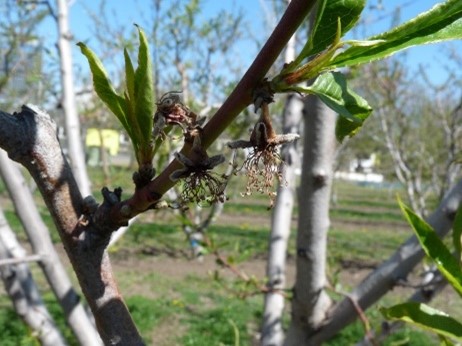A French network of experimental orchards to study the impact of climate change on phenology
In order to assess the consequences of global change, a network of experimental orchards for the observation of fruit trees has been set up throughout France on the initiative of the INRAE. This system, set up in 2015, makes it possible to study the impact of different environmental conditions on the functioning of 4 fruit species: apricot, cherry, peach and apple.
The plant material was planted in 6 orchards managed by INRAE units and characterised by contrasting climatic conditions:
- UE Horticole Angers
- UE Arboricole Toulenne
- UMR PIAF Clermont-Ferrand
- UE Diascope Mauguio
- UE A2M (L’Amarine)
- UERI Gotheron

Establishment of a network for the observation of the phenology of fruit species.
The lack of long-term systems for observing the phenology of fruit species, covering a wide range of soil and climatic situations, led INRAE to set up a networked observatory orchard in 2015 as part of the PERPHECLIM project, funded by the ACCAF meta-programme.
It was set up to study the response of phenology to climate change using the fruit species studied at the Institute. It is the first IGE (genotype-environment interaction) network dedicated to fruit species at INRAE.

Plant material
The experimental design was based on 4 fruit species (apricot, cherry, peach and apple), each represented by 5 cultivars covering the reasonable range of variation in phenological response of cultivars grown in France. Within each species, each cultivar is represented by 15 samples divided into 3 blocks..


Harmonised and standardised phenological observations
The aim of the observations was to determine the phenology and, in particular, the dates of flowering, maturity and senescence of the four target species, covering the range of earliness for each of the five varieties. The procedures for observing the main phenological stages were harmonised, in particular by using the BBCH rating scale (Meier, 1994) and the phenological stage charts taken from the book Les plantes au rythme des saisons (Badeau et al., 2017).
We are interested in traits related to phenology, which is the study of the seasonal rhythms of living organisms determined by seasonal variations in climate. These observations on fruit trees are part of the wider TEMPO framework, a national network of observatories dedicated to the phenology of all living organisms (plant and animal species, farmed and wild). The DIVAE system is involved in the fruit observatory of the network and participates in intercalibration sessions in collaboration with the forest and vine observatories, in particular for the observation of leaf senescence.
The establishment phase of the orchard has allowed the acquisition of important data for understanding the interactions between climate and phenological processes, open data that are currently being deposited on the INRAE research.data.gouv.fr portal (e.g. Angers phenological data; Toulenne phenological data).
For several years now, it has also been used to support projects investigating the interaction between plants and the environment, always closely linked to phenology, such as winter dormancy processes under the control of abscisic acid or modulation of susceptibility to late frosts.
In order to increase the value of this system in a wider context, we wish to promote its availability to support the observation and study of any other environmentally regulated character in trees, as well as any other component of the agro-ecosystem for which this context could prove relevant. In order to maintain its original vocation of phenological monitoring, 1 block of 5 trees out of the 3 blocks will have to remain intact, but sampling and manipulations that do not affect the survival of the trees could be carried out in the remaining two blocks..

Projects in progress
Frostdefend (LIFE) Système de prédiction et de protection des fruitiers contre le gel (https://frostdefend.eu/en/).
Haltogel (Feader) Evaluation et recherche de stratégies innovantes pour la protection des vergers contre les gelées de printemps en Région Sud
Protecfroid (ANR) Développer des outils de conseil agricole pour atténuer les risques de gel des plantes.
Doréa (INRAE BAP) Dormance et protection contre les stress climatiques : Evaluation de l'acide abscissique comme marqueur générique chez les espèces pérennes.
More informations
- Bénédicte Wenden, Aline Faure, David Lanoue, Guillaume Charrier. DIVAE - A French network of experimental orchards to study climate change impact on phenology. PHENOLOGY 2022 - Phenology at the crossroads, Jun 2022, Avignon, France. ⟨hal-03736372⟩
- https://divae.hub.inrae.fr/
- Données phénologiques Angers : https://doi.org/10.15454/SCTMIU
- Données phénologiques Toulenne : https://doi.org/10.15454/TJTV6N

